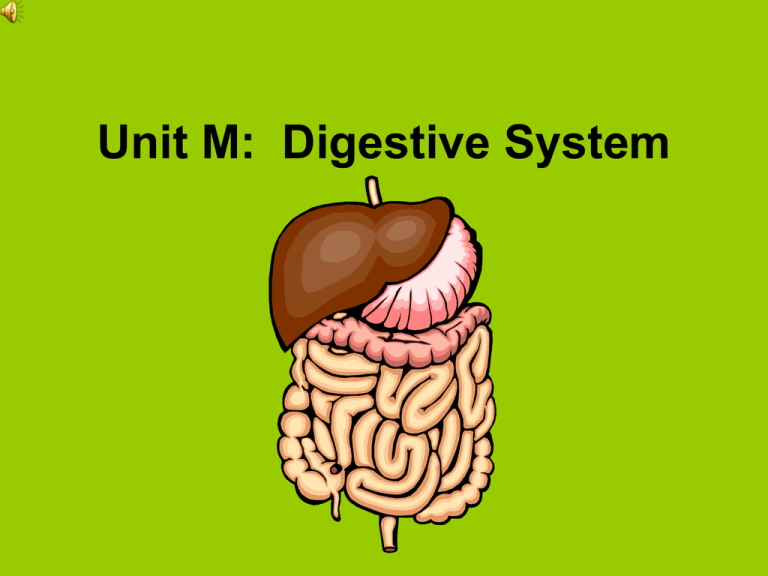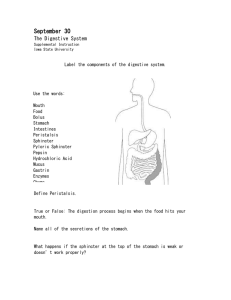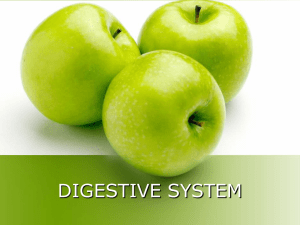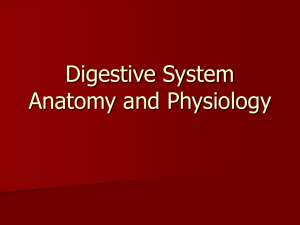Accessory organs of digestion
advertisement

Unit M: Digestive System DIGESTION The process of changing complex solid foods into simpler soluble forms which can be absorbed by body cells. ENZYMES Chemical substances that promote chemical reactions in living things. Ptyalin in saliva converts starches to simple sugars causes the initial chemical breakdown. ALIMENTARY CANAL Digestive tract or gastrointestinal tract (GI Tract). A 30 ft. tube from mouth to anus. Accessory organs of digestion: • • • • • • Tongue Teeth Salivary glands Pancreas Liver Gall bladder PERITONEUM Double-layered serous membrane that lines the abdominal cavity. Functions of the Digestive System • Physical breakdown of food • Chemical digestion of food into the end products of fat, carbohydrates and protein. • Absorb nutrients into blood capillaries of the small intestines • Eliminate waste products of digestion Structure of Organs of Digestion MOUTH • Food enters digestive system through mouth • Inside of mouth covered with mucous membrane – created here is a bolus-soft, pliable ball of semi-digested food. • The physical breakdown of food begins here first…digestion begins in the mouth Structure of Organs of Digestion • Roof of mouth is HARD PALATE (bone) and soft palate. Separates the mouth from the nasal cavity. UVULA – flap that hangs off soft palate – prevents food from going up the nose when you swallow TONGUE • Attached to floor of mouth • Muscular organ • Helps aid with chewing and swallowing of food. • Made of skeletal muscle attached to four bones • Taste buds on the surface SALIVARY GLANDS-secretes a watery fluid in the mouth • Three pairs of glands – Parotid is the largest…becomes inflamed with the mumps • All salivary glands secrete saliva TEETH • GINGIVA – gums support and protect teeth MASTICATION = chewing, teeth help in mechanical digestion Adult mouth has 32 teeth (incl. wisdom teeth) DECIDUOUS teeth – baby teeth total = 20 ESOPHAGUS • Muscular tube, 10” long that moves food from the pharynx to the stomach . • Connects pharynx and stomach STOMACH • Upper part of abdominal cavity • CARDIAC SPHINCTER – circular layer of muscle, controls passage of food into stomach and keeps it from going back into the throat. PYLORIC SPHINCTER – valve, regulates the entrance of food into duodenum RUGAE – mucous coat lining of stomach in folds when the stomach is empty Stomach has muscular coat that allows it to contract (peristalsis) and push food into the small intestine SMALL INTESTINE • Between stomach and large intestines • DUODENUM – first segment, curves around pancreas, 12” long. It receives bile from the gallbladder and liver. • BEGINNING of the small intestines. • JEJUNUM – next section, 8 ft. long – middle sect. • ILEUM – final portion, 10-12 feet long • ABSORPTION – in small intestine - digested food passes into bloodstream & lymph and on to body cells - indigestible passes on to large intestine Accessory Organs of Digestion PANCREAS • Located behind stomach • Exocrine function – secretes digestive enzymes to break down food. • Also has endocrine function. • Feather shaped organ LIVER • Largest organ in the body • Located below the diaphragm, upper right quadrant • Connected to gallbladder and small intestine by ducts Functions • Produce and store glucose in the form of GLYCOGEN • Detoxify alcohol, drugs and other harmful substances • Manufacture blood proteins • Manufactures bile • Store Vitamins A, D and B complex GALL BLADDER • Small muscular green sac that secretes and stores bile • Located in the right upper quadrant of abd. cavity. • When fatty foods digested, bile released by gallbladder LARGE INTESTINE • CHYME – semi-liquid food and gastric juices • Approx 2” in diameter • Also called the colon • CECUM – lower right portion of large intestine • APPENDIX-blind sac attached to cecum, having no known function • RECTUM – last portion of large intestine • ANUS – external opening of the Lg. intestine Digestion • BOLUS – soft, pliable ball – created from chewing and addition of saliva – it slides down esophagus • PERISTALSIS – wavelike motions, moves food along esophagus, stomach and intestines In the mouth… • Saliva softens food to make it easier to swallow • PTYALIN in saliva converts starches into simple sugar - under nervous control – just thinking of food can cause your mouth to water In the stomach… • gastric (digestive) juices are released • stomach walls churn and mix, partially digested food in the stomach is called chyme. • small amount of chyme enters duodenum at a time - controlled by pyloric sphincter • takes 2-4 hours for stomach to empty Small intestine-located between the stomach & Lg intestines 1. Where digestion is completed and absorption occurs by passing nutrients to blood stream. 2. Enzymes from pancreas and bile from liver/gallbladder are added. The Large Intestine • Regulation of H2O balance by absorbing large quantities back into bloodstream • bacterial action on undigested food – decomposed products excreted through colon – bacteria form moderate amounts of B complex and Vitamin K. Large Intestines cont… • FECES – undigested semisolid consisting of bacteria, waste products, mucous and cellulose • DEFECATION – when large intestine fills, defecation reflex triggered –external anal sphincter under conscious control • Gas formation – 1-3 pints/day, pass it through rectum (FLATULENCE) 14 times a day…bacteria produce the gas • HEARTBURN or ACID REFLEX - when gastric juices are regurgitated into the esophagus. • Symptoms – burning sensation • Rx – avoid chocolate and peppermint, coffee, citrus, fried or fatty foods, tomato products – stop smoking – take antacids – don’t lay down 2-3 hours after eating GASTROENTERITIS • Inflammation of mucous membrane lining of stomach and intestine • Common cause = virus • Symptoms – diarrhea and vomiting for 24-36 hours • Complication = dehydration ULCER • Sore or lesion that forms in the mucosal lining of the stomach • Gastric ulcers in the stomach and duodenal ulcers in the duodenum • Cause – H. pylori (bacteria) is primary cause • Lifestyle factors that contribute: cigarette smoking, alcohol, stress, certain drugs Ulcer Continued • Symptoms – burning pain in abdomen, between meals and early morning, may be relieved by eating or taking antacid • Diagnosis – x-ray, presence of bacteria • Rx – H2 blockers (drugs) that block release of histamine APPENDICITIS • When appendix becomes inflamed • If it ruptures, bacteria from appendix can spread to peritoneal cavity HEPATITIS A • Infectious hepatitis • Cause – virus • Spread through contaminated food or H2O HEPATITIS B (Serum Hepatitis) • Caused by virus found in blood • Transmitted by blood transfusion or being stuck with contaminated needles (drug addicts) Health care workers at risk and should be vaccinated • Use standard precautions for prevention CIRRHOSIS Chronic, progressive disease of liver Normal tissue replaced by fibrous connective tissue. 75% caused by excessive alcohol consumption CHOLECYSTITIS • Inflammation of gallbladder CHOLELITHIASIS Gallstones • Gallstones can block the bile duct causing pain between shoulder blades and digestive disorders….may cause JAUNDICE color. • Small ones may pass on their own, • Large ones surgically removed • Surgical removal of gallbladder = CHOLECYSTECTOMY GALLSTONES DIARRHEA • Loose, watery, frequent bowel movements when feces pass along colon too rapidly • Caused by infection, poor diet, nervousness, toxic substances or irritants in food CONSTIPATION • When defecation delayed, feces become dry and hard • Rx – diet with cereals, fruits, vegetables, (roughage), drinking plenty of fluids, exercise, and avoiding tension JAUNDICE Yellow color of the skin ~THE END~ I hope everything comes out Okay!









